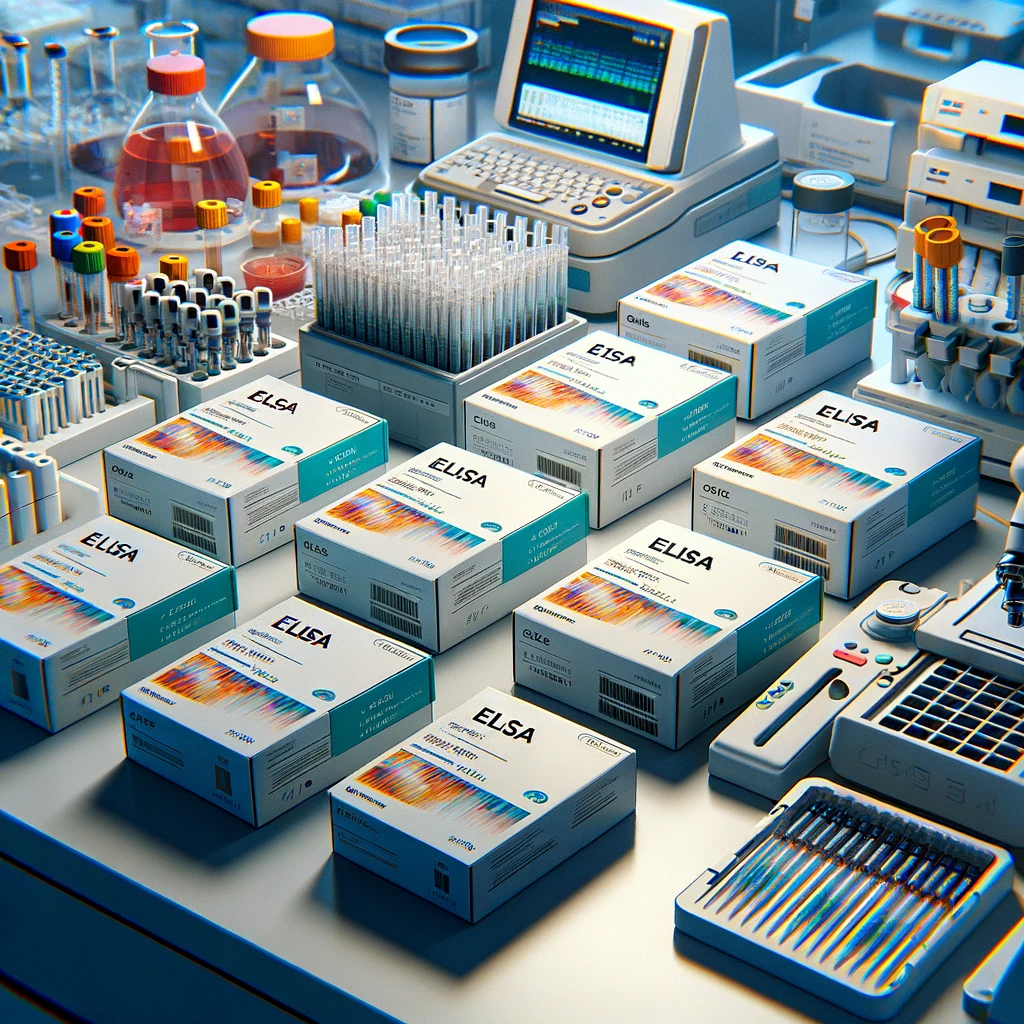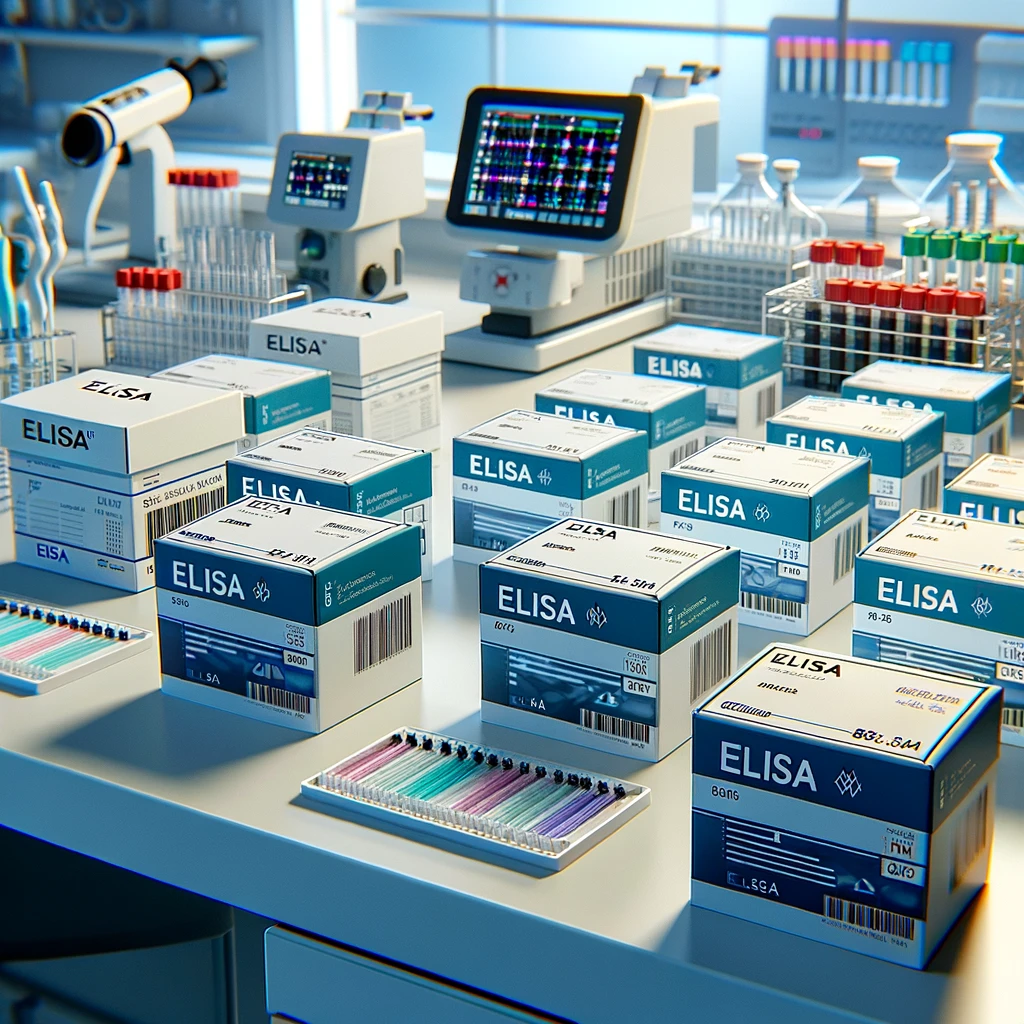What are ELISA Kits?
ELISA (Enzyme-Linked Immunosorbent Assay) kits are diagnostic tools used to detect the presence and quantify the amount of antibodies or antigens in a biological sample such as blood, serum, or cell culture supernatant. They work on the principle of an antigen-antibody binding reaction.
ELISA kits contain pre-coated microtiter plates with a target antigen or antibody. The test sample containing the antibody or antigen of interest is added to the plate. If the target is present, it will bind to the pre-coated antigen/antibody. After washing away unbound substances, an enzyme-linked secondary antibody is added that recognizes and binds to the antigen-antibody complex.
An enzyme-substrate reaction is then used to develop color in proportion to the amount of antigen-antibody binding. The color is measured spectrophotometrically, allowing quantification of the target analyte in the test sample. Different types of ELISA kits are available based on the analyte and assay format used.
Common Types of ELISA Kits:
- Antigen ELISA – Detects presence of antigens
- Antibody ELISA – Detects antibody levels in response to antigens
- Sandwich ELISA – Used for detecting native antigens
- Competitive ELISA – Used for small molecule antigens or hormones
Applications of ELISA Kits:
- Disease diagnosis – Detect infection or autoimmune disorders
- Therapeutic drug monitoring – Measure drug levels in patients
- Biomedical research – Study protein-protein interactions
Advantages of ELISA include high sensitivity and specificity, cost-effectiveness, and ability to analyze multiple samples simultaneously. ELISA kits provide a simple and reliable method for detecting and quantifying proteins in clinical and research settings. Proper handling and storage of kits is important to ensure accurate results.
In summary, ELISA kits are versatile tools that utilize the antigen-antibody reaction to detect and quantify proteins in biological samples, with wide applications in healthcare and research.
Choosing the Right ELISA Kit There are many ELISA kits available for different target proteins. When selecting a kit, consider:
- Target analyte – Choose a kit specific to the protein/biomarker of interest.
- Sample type – Kits are available for serum, plasma, tissue lysates, cell culture media, etc. Match your sample.
- Sensitivity – Check the minimum detection limit and ensure it’s low enough for your application.
- Specificity – Make sure the kit has high specificity to avoid cross-reactivity issues.
- Species reactivity – Kits may work for only one species or be multi-species. Verify compatibility.
- Format – Choose a kit size based on number of samples to test. 96-well and 384-well formats are common.
Running the ELISA Proper technique is key to getting accurate results:
- Dilute samples as instructed and load in duplicate wells.
- Incubate plates at optimal temperature and time for binding reactions.
- Wash thoroughly between steps to remove unbound material.
- Add substrates and stop solutions precisely as indicated.
- Read absorbance within the recommended time frame on a plate reader.
Interpreting ELISA Results Based on standards provided, ELISA data can be used to:
- Determine presence/absence of target based on cutoff threshold.
- Quantify absolute concentration of target protein in unknown samples.
- Compare relative levels between test groups or across time points.
- Monitor changes in response to therapy or disease progression.
Proper storage and handling of kits ensures long shelf life and reproducible results. Following protocols closely delivers reliable, quantitative measurements by ELISA.
Introduction to Enzyme-Linked Immunosorbent Assay
Enzyme-Linked Immunosorbent Assay, commonly known as ELISA, stands as a cornerstone in the field of immunology and biotechnology. This powerful technique is utilized to detect the presence of antibodies or antigens in a sample, playing a crucial role in diagnostics, research, and even food safety. Its versatility and sensitivity make it an invaluable tool in various scientific domains, from diagnosing infections to ensuring the safety of our food supply.
The Science Behind ELISA
At the heart of ELISA lies a simple yet profound principle: the specific binding between an antigen and its corresponding antibody. This technique can be classified into four main types – direct, indirect, sandwich, and competitive – each tailored for specific applications and offering distinct advantages. Understanding these types sets the stage for grasping how ELISA can be harnessed to yield critical insights in both research and clinical settings.
Components of ELISA
The ELISA assay is a symphony of components working in harmony: antibodies and antigens form the core of the detection mechanism, enzymes act as amplifiers of the signal, and substrates become the visual or measurable output. The choice of plates and detection methods further customizes the assay, making ELISA a highly adaptable tool for various analytical needs.
Procedure of ELISA
The ELISA process unfolds through meticulously designed steps, beginning with sample preparation and culminating in signal detection and interpretation. Each phase is critical, from coating the plate with antigens or antibodies to introducing the enzyme-substrate reaction that brings the final results to light. This section will walk through the ELISA procedure, demystifying how each step contributes to the assay’s overall success.
Applications of ELISA
ELISA’s applications are as diverse as they are impactful. In disease diagnosis, it serves as a frontline tool for detecting pathogens and monitoring immune responses. Its role in vaccine development is equally significant, providing insights into the efficacy and safety of immunizations. Moreover, ELISA’s contributions to food safety, through the detection of allergens and contaminants, underscore its importance in public health and regulatory compliance.
Advantages of ELISA
ELISA’s widespread adoption can be attributed to its numerous advantages, such as high sensitivity and specificity, versatility across a range of applications, and cost-effectiveness. These benefits make ELISA an indispensable method in laboratories around the world, facilitating breakthroughs in medical research and ensuring the wellbeing of populations.
Challenges and Limitations
Despite its strengths, ELISA is not without its challenges. Issues such as cross-reactivity can lead to false positives or negatives, while technical hurdles demand precise optimization of the assay conditions. This section will explore these limitations and discuss strategies to overcome them, ensuring reliable and accurate results.
Recent Advances in ELISA Technology
The landscape of ELISA is constantly evolving, with recent advances pushing the boundaries of what’s possible. Automation and high-throughput screening have revolutionized the efficiency of ELISA assays, while novel detection methods enhance sensitivity and specificity. The integration of ELISA with other technologies opens new avenues for diagnostic and research applications, marking an exciting era of innovation in this field.
Comparative Analysis of ELISA with Other Diagnostic Methods
ELISA doesn’t exist in isolation; it’s part of a broader toolkit of diagnostic methods. This section compares ELISA with alternatives like PCR, Western Blot, and lateral flow assays, highlighting each method’s strengths and situational advantages. Understanding these comparisons helps clarify ELISA’s unique role in the diagnostic landscape.
ELISA in Vaccine Development
The development of safe and effective vaccines is a complex process, and ELISA plays a critical role in it. By evaluating immune responses to various vaccine candidates, ELISA aids in identifying those with the potential to confer robust immunity. This segment will delve into how ELISA contributes to vaccine development, ensuring the creation of vaccines that can stand up to the challenge of preventing diseases.
ELISA in Food Safety
In the realm of food safety, ELISA acts as a guardian, screening for the presence of allergens, pathogens, and contaminants. Regulatory bodies rely on ELISA for its accuracy and reliability, setting standards that ensure the food industry maintains the highest safety levels. This section will explore ELISA’s applications in food safety, from detecting gluten in gluten-free products to identifying residues of antibiotics in animal products.
Troubleshooting Common ELISA Problems
Even the most experienced scientists can encounter issues with ELISA assays. Common problems range from coating and blocking issues to optimizing signal detection for consistency and reproducibility. This practical guide will offer solutions and tips for troubleshooting, helping researchers navigate the challenges of ELISA assays.
Interpreting ELISA Results
Interpreting ELISA results is both an art and a science, requiring a deep understanding of quantitative and qualitative analysis. This section will explain how to read ELISA results accurately, including the role of the standard curve and factors that can influence the interpretation of data.
ELISA Kits and Commercial Solutions
The market offers a plethora of ELISA kits, each designed for specific applications. Choosing the right kit is crucial for the success of an assay. This guide will provide an overview of available kits, offering advice on selecting the best option for a given application, whether it’s a custom kit for unique research needs or a pre-made kit for common assays.
Safety and Ethical Considerations
Working with ELISA involves handling biohazardous materials and raises ethical considerations, especially in research and testing. This section will address the best practices for safety and ethical conduct, ensuring that ELISA is used responsibly and with the utmost regard for health and ethical standards.
Future Directions in ELISA Development
As we look to the future, the potential for ELISA’s evolution is boundless. Innovations in nanotechnology and the development of point-of-care ELISA devices promise to bring this powerful diagnostic tool directly to patients’ bedside. This concluding section will speculate on future applications and technological advancements in ELISA, envisioning how it will continue to contribute to science and medicine.
Our ELISA kits are designed to provide accurate and reliable results for a wide range of research and diagnostic applications. With easy-to-follow protocols and high-quality reagents, our ELISA kits are trusted by researchers and clinicians worldwide.


